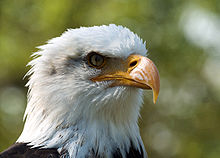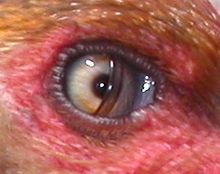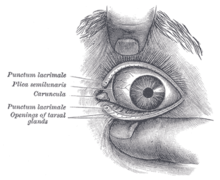- Nictitating membrane
-
 The nictitating membrane of a Masked Lapwing as it closes.
The nictitating membrane of a Masked Lapwing as it closes.
The nictitating membrane (from Latin nictare, to blink) is a transparent or translucent third eyelid present in some animals that can be drawn across the eye for protection and to moisten it while maintaining visibility. Some reptiles, birds, and sharks have a full nictitating membrane; in many mammals, there is a small vestigial remnant of the membrane in the corner of the eye. Some mammals, such as camels, polar bears, seals, and aardvarks, have a full nictitating membrane. It is often called a third eyelid or haw and may be referred to as the plica semilunaris or palpebra tertia in scientific terminology.
Nictitating membranes are found in birds, reptiles, amphibians, and fish, and mammals, but are rare in primates.[1][2] In humans, the plica semilunaris (also known as the semilunar fold) and its associated muscles are thought to be probably homologous to the nictitating membrane seen in some other mammals and other vertebrates.[3] Only one species of primate—the Calabar Angwantibo—is known to have a functioning nictitating membrane.[4]
 The nictitating membrane (mid-blink) of a Bald Eagle
The nictitating membrane (mid-blink) of a Bald Eagle
Unlike the upper and lower eyelids, the nictitating membrane moves horizontally across the eyeball. It is normally translucent. In some diving animals, for example beavers and manatees, it moves across the eye to protect it while under water, and in these species it is transparent; in other diving animals including sea lions, it is activated on land, to remove sand and other debris. This is its function in most animals. In birds of prey, it also serves to protect the parents' eyes from their chicks while they are feeding them, and when peregrine falcons go into their 200 mph (320 km/h) dives, they will blink repeatedly with the nictitating membrane to clear debris and spread moisture across the eye. In polar bears it protects the eyes from snow blindness. In sharks it protects the eye while the shark strikes at its prey. Woodpeckers tighten their nictitating membrane a millisecond prior to their beak impacting the trunk of a tree in order to prevent shaking-induced retinal injury.[5]
The nictitating membrane in cats and dogs does not have many muscle fibers and consequently is not usually visible, and its being chronically visible should be taken as a sign of poor condition or ill health. It can, however, be seen clearly when gently opening the eye of the healthy animal when it is asleep, or pushing down/applying pressure on the eyeball will cause it to appear. In some breeds of dogs, the nictitating membrane can be prone to prolapse, resulting in a condition called cherry eye. Birds can actively control their nictitating membrane[6]
In many species, any stimulus to the eyeball (such as a puff of air) will result in reflex nictitating membrane response. This reflex is widely used as the basis for experiments on classical conditioning in rabbits.[7]
See also
References
- ^ Owen, R. 1866–1868. Comparative Anatomy and Physiology of Vertebrates. London.
- ^ Why do cats have an inner eyelid as well as outer ones? Scientific American. 20 Nov 2006. (Accessed 2 Nov 2011)
- ^ The Eye: Basic Sciences in Practice by John V. Forrester, p. 82
- ^ Montagna, W., Machida, H., and Perkins, E.M. 1966. The skin of primates XXXIII.: The skin of the angwantibo. American Journal of Physical Anthropology. Vol. 25, 277–290.
- ^ Wygnanski-Jaffe T, Murphy CJ, Smith C, Kubai M, Christopherson P, Ethier CR, Levin AV. (2007) Protective ocular mechanisms in woodpeckers Eye 21, 83–89.
- ^ Frans C. Stades, Milton Wyman, Michael H. Boevé, Willy Neumann, Bernhard Spiess. Ophthalmology for the Veterinary Practitioner. 105-106.
- ^ Gormezano, I. N. Schneiderman, E. Deaux, and I. Fuentes (1962) Nictitating Membrane: Classical Conditioning and Extinction in the Albino Rabbit Science 138:33–34.
Categories:- Eye
- Vertebrate anatomy
Wikimedia Foundation. 2010.


